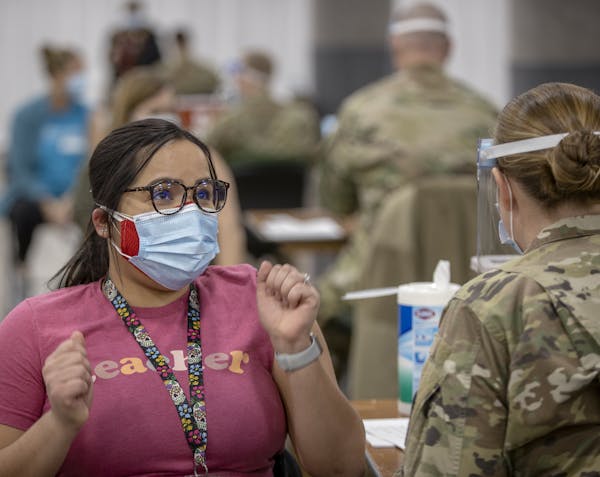Gov. Tim Walz on Thursday said Minnesota has a "golden opportunity" against COVID-19 because a more stable vaccine supply is coming at the same time as the pandemic has dropped below a key measure for severity.
Following a tour of a mass vaccination site in Brooklyn Center, the governor said he was encouraged because the positivity rate of diagnostic testing for COVID-19 had dropped below 5% in Minnesota for only the second time since Sept. 17. The rate peaked at 15.5% on Nov. 10 amid a severe wave that filled hospitals to near capacity.
"That is a huge win for all of us," Walz said. "That means less people are getting it, it's spreading at a slower rate, and more people are getting vaccinated. So we're starting to win that fight a little bit."
Through Tuesday, 320,347 people had received at least a first dose of the two-dose COVID-19 vaccine in Minnesota, and 85,217 people had completed the series.
The state's immediate supply of federally controlled vaccine increased to 826,625 first and second doses, but Walz said the state for the first time on Thursday received a three-week estimate that includes a 16% increase in shipments.
Heightened interest and scarce supply have fueled criticisms of the state's vaccine approach, which followed federal guidance to prioritize health care workers and long-term care residents.
Some were upset that nonmedical workers at Allina Health in Minneapolis and Mayo Clinic in Rochester received early access to the vaccine, while others questioned the vaccination of workers at places such as the Minnesota Zoo even though they qualified as emergency medical first responders.
Outpatient clinicians and dentists are to be in the priority group, but many are still waiting even as Minnesota this week launched a mass vaccination in St. Paul of 15,000 teachers and conducted a second week of vaccinations for people 65 and older at nine sites around the state.
Walz said he is in the "doghouse" because his mother-in-law was among the more than 200,000 who entered a lottery for vaccination at those sites this week but was not selected for one of fewer than 10,000 appointments.
He encouraged "a good neighbor" approach among Minnesotans to make sure the neediest people get vaccinated first against a pandemic that has caused 6,140 deaths and 458,633 known infections. People 65 and older have suffered 13% of known infections but 89% of COVID-19 deaths — including 15 of 16 deaths reported Thursday in Dakota, Hennepin, Isanti, Kittson, Olmsted, Ramsey, Rice, Sherburne, Stearns and Washington counties.
Twelve of the deaths reported Thursday involved residents of long-term care who are at elevated risk of COVID-19 due to their age and underlying health conditions.
Minnesota has been criticized for a slow vaccine rollout, and the state ranks 41st among states for per-capita rate of doses administered, according to the U.S. Centers for Disease Control and Prevention. However, state officials said comparative data are starting to show the strength of Minnesota's approach, which included training for providers in December that delayed the start of vaccinations.
The state's medical providers and pharmacies administered 407,063 doses and wasted 107 as of Tuesday, despite the complexities of the Pfizer version, which must be kept in ultracold storage and used within five days once thawed.
Most of the wasted doses were due to issues with thawing and freezing; one five-dose vial was cracked, and another was lost.
"As a percentage, it's very small … but we just view every wasted dose as a missed opportunity," state Health Commissioner Jan Malcolm said.
Despite the poor per-capita ranking on first doses, Minnesota ranks 15th for its rate of second doses administered. Both the Pfizer and Moderna COVID-19 vaccines are considered 95% effective if provided on schedule. Florida has received acclaim for jumping ahead in the vaccination of senior citizens, but while its first-dose rate ranks 10th, its second-dose rate ranks 41st.
Malcolm said Minnesota's performance in completing vaccinations reflects its reliance on existing medical providers to give most of the doses and to immediately arrange appointments for second shots.
"The fact that we're really good at second doses speaks to the underlying competency of the system," she said.
Walz and Malcolm stressed that vaccine distribution by health care providers will continue to be the mainstay of Minnesota's approach, despite the launch of the state mass vaccination events.
The expansion has upset some Minnesotans who are younger than 65 but have underlying health conditions that were supposed to put them at least in line for vaccine at the same time as seniors.
Nobody is even talking publicly about when this group will be prioritized for vaccine, said Anne Johnson, 60, of Wayzata, who is receiving chemotherapy for cancer.
"Originally [we were] part of the 1C category," she said. "There is now just silence."
The state has encouraged medical providers to sign up patients 75 and older for any vaccine appointments that aren't filled by health care workers, but the response has varied.
Essentia Health in Duluth is reaching out to patients 65 and older and started a mobile clinic to vaccinate unaffiliated health care workers.
Allina and Fairview Health started reaching out this week to offer limited vaccinations to patients 75 and older in addition to health care workers.
Mayo started offering vaccine to medical providers outside of its health system and prioritized 6,000 patients 80 and older for open appointments, because they are at greater risk than people in their 60s and 70s.
"Somehow you have to figure out, do you open it up to everyone over 65 and it becomes kind of a race by everybody to get in?" said Dr. Abinash Virk, a co-leader of Mayo's COVID-19 vaccine program, "or should one approach it from a risk standpoint?"
Staff writer Glenn Howatt contributed to this report.
Jeremy Olson • 612-673-7744

Apple Valley Police Department relaxes strict vehicle-pursuit policy

Scene Makers Q+A: Rochester store owners head up Winona's Mid West Music Fest this weekend

Brooks: No funding, no lab, no problem for dogged University of Minnesota student inventors

